The AMD Trinity Review (A10-4600M): A New Hope
by Jarred Walton on May 15, 2012 12:00 AM ESTAMD Trinity: Battery Life Also Improved
With all of the changes going into Trinity, one thing that hasn’t changed since Llano is the process technology. Trinity is once again coming on a 32nm process from GlobalFoundries. If we were talking about Intel, Trinity would represent a “Tock” on the roadmap—a new architecture on an existing process. We’ve looked at CPU and GPU performance, and this is a part that’s pretty much universally faster than its predecessor. Given the lengthier pipeline and Bulldozer-derived architecture, I admit that I was concerned Trinity might actually be a step back for battery life; it appears that my fears were unfounded, largely due to the improvements in Piledriver. As usual, we tested with all laptops set to 100 nits brightness in our idle, Internet, and H.264 playback tests. I also ran some additional tests which we’ll discuss in a moment. First, here are the standard battery life results:
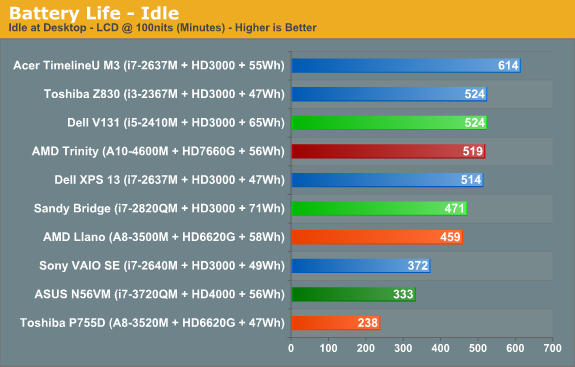
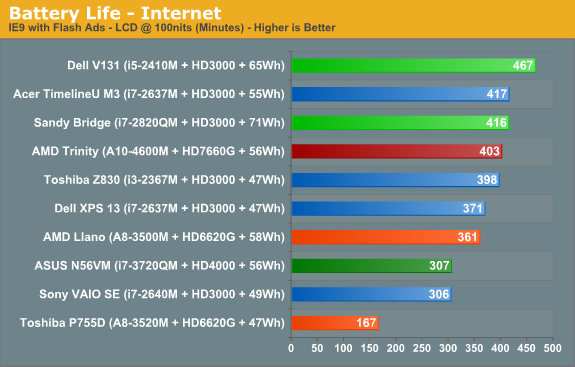
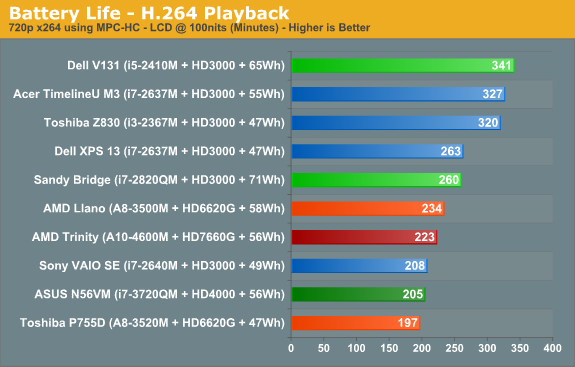
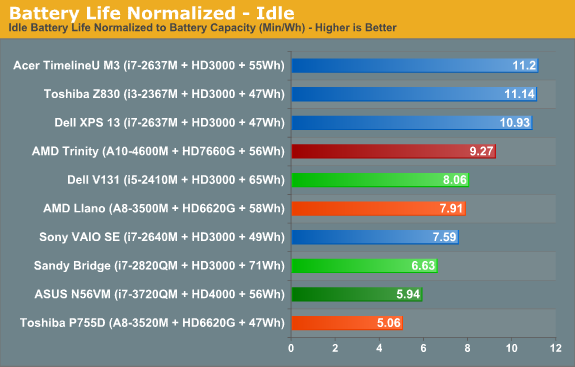

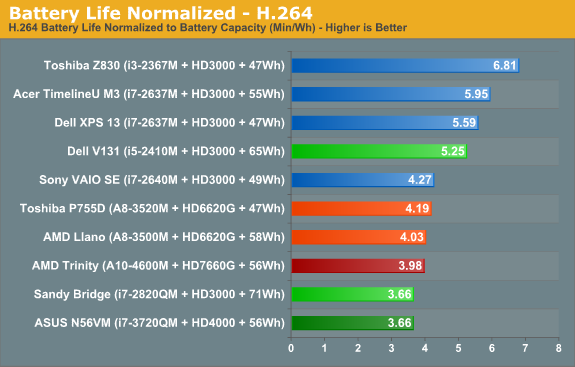
With a similar capacity battery to the original Llano laptop, and the same size 14” panel, Trinity comes out of the gates and posts two clear wins: idle battery life and Internet battery life are both up substantially relative to Llano. In fact, looking at the normalized charts, the only laptops that can consistently beat Trinity are found in Sandy Bridge ultrabooks—we won’t even bother discussing Atom or Brazos netbooks, as they’re competing in a completely different performance bracket. In something of a surprise, H.264 battery life doesn’t see the same benefit unfortunately, and it’s the one discipline where Llano still holds on to a slight lead over Trinity. Sandy Bridge meanwhile has always done very well in H.264 battery tests, and we see that with the Vostro V131 posting a normalized score that’s 30% better than Trinity and Llano. Of course, on the other end of the spectrum we have Ivy Bridge; we’ve only looked at one Ivy Bridge laptop so far, but if the pattern holds than Ivy Bridge will generally be a moderate step back in battery life relative to Sandy Bridge, giving AMD an even larger lead in this area.
We also performed a few other tests that we won’t present in graph form. One set of tests we alluded to earlier: the charts show Trinity with a Samsung 830 SSD, but we also ran tests with an Intel 520 SSD. Idle battery life dropped to 476 minutes (an 8% decrease), Internet battery life checked in at 371 minutes (down 8% again), and H.264 battery life stayed nearly the same at 217 minutes (down less than 3%). If battery life is one of your primary concerns, remember: all SSDs are not created equal!
Another test that we ran is simulated gaming; we looped the four graphics tests in 3DMark06 at 1366x768 until the battery ran out. We’ve run this same test on quite a few other laptops, and Llano initially looked to be far and away the best solution. Later, we discovered that when we tested Llano we were letting the GPU run in power saving mode—basically half the performance you’d get compared to being plugged in. We retested and measured 98 minutes, so the extra graphics performance comes with a heavy cost. We only tested Trinity (and Ivy Bridge and Sandy Bridge) using higher performance graphics settings, and this is one more area where it scores worse than Llano: Trinity managed just 77 minutes. That’s about the same as Ivy Bridge and Sandy Bridge (79 and 73 minutes, respectively), so if you’re after better gaming performance while running off the mains, you might need to keep looking.
Before getting too carried away with the above results, you still need to consider how important battery life is for your usage model. Some people travel a lot and like to go all day without plugging in; others will go from place to place and plug in whenever they’re not on the go. If you fall in the latter category, battery life isn’t usually a problem with any decent laptop, while those looking for all-day computing will definitely want as much mobility as possible. Ultimately, battery life is a factor of battery capacity as well as power optimizations done by the OEMs. We’ve seen battery life improve by as much as 50% when comparing two otherwise similar notebooks, but at least AMD’s reference platform for Trinity delivers a great starting point.
Temperatures and Acoustics
One other item we wanted to quickly touch on is system temperatures. We typically use HWMonitor and check temperatures of laptops under idle and load conditions. We did this with Trinity as well, but unfortunately the current version of HWMonitor doesn’t give us a lot of information. The only temperatures it reports are from the SSD and the HD 7660G graphics—there’s nothing about CPU core temperatures. That means we can’t provide much detail, other than to say that load temperature on the GPU topped out at 71C during extended testing, while the idle temperature was 39C. As usual, temperatures and noise levels go hand in hand, and the low 71C maximum GPU temperature matches up nicely with noise levels that never got above 37dB. It’s not the quietest laptop we’ve ever tested, and surface temperatures can get a little warm, but overall Trinity looks to be a good balance of performance and power requirements, which means quiet laptops are definitely possible.










271 Comments
View All Comments
Beenthere - Tuesday, May 15, 2012 - link
Many students game on laptops and that's a large market segment with many people desiring portability by necessity these days.aliasfox - Tuesday, May 15, 2012 - link
Your average kid going into undergrad who doesn't care enough to spend more than $1k (or more than $700) for a computer will be pleasantly surprised when he/she fires up some random game - and releasing these machines right now is perfect timing to get product on the shelves for college back-to-school season.It's really all about 'good enough' on SC2 or Portal or whatever else people will pick up for a few hours a week. They don't care about 100 fps at insane external monitor resolutions with megapixels worth of textures, but if they can get >20-30 fps at 768p or 900p on whatever they might throw at it, they're happy enough.
I used to be of them.
mikato - Wednesday, May 16, 2012 - link
Me too. I played Quake 3 on an 8MB video card for quite a while on my desktop and everything worked well enough for me to kick butt with the rail gun :) It was great to play for a few minutes or an hour to unwind a bit.Caltek9 - Tuesday, May 15, 2012 - link
jwcalla,I'm actually totally interested in gaming on a lower-end laptop right now, and am trying to decide whether to wait for Trinity or not. I'm going to grad school (undergrad and building gaming towers was many years and 2 children ago), and need a light laptop with good battery that I can play recent games on (Diablo III, Kingdoms of Amalur, Saints Row the Third, Borderlands). The reason the Trinity setup is intriguing to me is because if the GPU works out, I can get (supposedly/hopefully) a very slim laptop that can do this, instead of a heavier one. I'll be going to grad school in Europe, and every pound I can shave off before I travel is a good thing! I've been a console gamer for far too long (since abandoning the PC after undergrad), so I'm used to not having the best looking graphics. As long as it can play a game smoothly, and at decent graphical settings, I'm fine with that.
I get a bit sad when seeing the Trinity CPU numbers, but keep trying to convince myself that it won't matter to me, since I'll mainly be typing papers, and surfing the Internet, and not transcoding anything with gaming on the side. I'm writing this on an Intel-based Mac, so I'm not a fanboy of either AMD.
Bottom Line: I want cheap, light, good battery, and the ability to play recent games at medium settings. Trinity seems to be able to do this better than Ivy Bridge, at least in these early reviews.
SIDE NOTE: Until I see an actual laptop with Trinity in the wild, this is my current choice for a replacement laptop (Sager NP6110/Clevo W110ER): http://www.xoticpc.com/sager-np6110-clevo-w110er-p...
I'm a bit worried about the screen and keyboard sizes for papers, but suppose I could hook them up to externals.
Gigantopithecus - Tuesday, May 15, 2012 - link
PCPer shows the A10-4600M absolutely trouncing the i7-3720QM (http://www.pcper.com/files/review/2012-05-13/gamet...What explains the dramatic discrepancy between their results and Anandtech's?
Gigantopithecus - Tuesday, May 15, 2012 - link
...in Skyrim, and here's a working link: http://www.pcper.com/files/review/2012-05-13/gamet...tipoo - Tuesday, May 15, 2012 - link
Anandtech tested at low details, in your link its medium. The HD4000 has decent pixel fill rate, but pretty bad pixel shader performance. So more details = it falls further behind.JarredWalton - Tuesday, May 15, 2012 - link
Good try, but you're wrong. We test at Medium details, with FXAA disabled and anisotropic filtering set at 4x. We also have the high resolution texture pack installed, though I'm not sure if it's always active at low details. Finally, Skyrim is a massive game. I specifically ran around looking for areas (on my desktop system) where performance was lower so that we could give more of a "this is as bad as it gets" score. That ended up being near Whiterun. Go into dungeons and such and the game runs two or three times as fast as our benchmark section.tipoo - Tuesday, May 15, 2012 - link
My mistake, I read "value" and assumed low settings. So if they were both at medium, why are the winner and loser completely flipped? Your explanation would explain the lower framerate, but not a complete flipping of winner and loser.JarredWalton - Tuesday, May 15, 2012 - link
It could be that Whiterun has lower framerates because of CPU bottlenecks as opposed to GPU bottlenecks. I honestly don't know, and I don't know what areas others are using for testing. I suppose I could always try benchmarking a different section of the game to see what happens.It's also possible that FXAA and anti-aliasing in general is the cause of the discrepancy. I never turn on AA personally until I'm at the point where I've maxed out other settings and I still have room to spare. Jaggies just don't bother me all that much, particularly at native resolution on LCDs, and FXAA is basically a blur filter for the whole screen -- you lose jaggies as well as details.